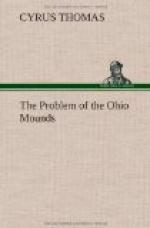Though hundreds of groups of mounds marking the sites of ancient villages are to be seen scattered over the Mississippi Valley and Gulf States yet nowhere can there be found an ancient house. The inference is therefore irresistible that the houses of the mound-builders were constructed of perishable materials; consequently that the builders were not sufficiently advanced in art to use stone or brick in building, or else that they lived a roving, restless life that would not justify the time and trouble necessary to erect such permanent structures. As the last inference is irreconcilable with the magnitude and extent of many groups of these remains we are forced to the conclusion that the first is true.
One chief objection to the Indian origin of these works is, as already stated, that their builders must have been sedentary, depending largely upon agriculture for subsistence. It is evident, therefore, that they had dwellings of some sort, and as remains of neither stone nor brick structures are found which could have been used for this purpose, we must assume that their dwellings were constructed of perishable material, such as was supplied in abundance by the forest region in which they dwelt. It is therefore apparent that in this respect at least the dwellings of mound-builders were similar to those of Indians. But this is not all that can be said in reference to the houses of the former, for there still remain indications of their shape and character, although no complete examples are left for inspection. In various places, especially in Tennessee, Illinois, and southeast Missouri, the sites of thousands of them are yet distinctly marked by little circular depressions with rings of earth around them. These remains give the form and size of one class of dwellings that was common in the regions named. Excavations in the center usually bring to light the ashes and hearth that mark the place where the fire was built, and occasionally unearth fragments of the vessels used in cooking, the bones of animals on whose flesh the inmates fed, and other articles pertaining to domestic use.
During the explorations of the Bureau in southeastern Missouri and Arkansas, finding the remains of houses in low, flat mounds was a common occurrence. Although the wood in most cases had disappeared, what had not been converted to coals and ashes having rotted away, yet the size and form, and, in part, the mode of construction, were clearly indicated. The hard-tramped, circular, earthen floor gave the size and form; the numerous fragments of burnt clay forming a layer over the floor—often taken by explorers for brick-revealed the method of plastering their dwellings; the charred remains of grass and twigs showed that it had been strengthened by this admixture; the impressions left on the inner face of these lumps of burnt plastering revealed the character of the lathing, which was in some cases branches and twigs, but in others split cane. The roof was thatched with grass or matting, the charred remains of which were found in more than one instance. In probably nine cases out of ten it was apparent these dwellings had been burned. This was found to be due to the custom of burying the dead in the floor and burning the dwelling over them, covering the remains with dirt often before the fire had ceased burning.




